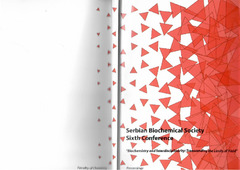Приказ основних података о документу
In vivo toxicity of naked and coated CeO2 nanoparticles
| dc.creator | Milenković, Ivana | |
| dc.creator | Radotić, Ksenija | |
| dc.creator | Despotović, Jovana | |
| dc.creator | Lončarević, Branka | |
| dc.creator | Lješević, Marija | |
| dc.creator | Nikolić, Aleksandra | |
| dc.creator | Beškoski, Vladimir | |
| dc.date.accessioned | 2023-03-22T08:29:47Z | |
| dc.date.available | 2023-03-22T08:29:47Z | |
| dc.date.issued | 2016 | |
| dc.identifier.isbn | 978-86-7220-081-2 | |
| dc.identifier.uri | http://rimsi.imsi.bg.ac.rs/handle/123456789/1840 | |
| dc.description.abstract | The use of nanomaterials in various commercial products and industrial processes has increased. Although the application of nanoparticles has great importance, some of them can be risky to human health and the environment. Cerium oxide nanoparticles CeO2 have been extensively investigated due to the excellent oxygen storage capacities on the basis of the redox transition between Ce3+ and Ce4+ and formation of oxygen vacancies on their surface. The effect of CeO2 on individual organisms and the ecosystem in general are not sufficiently explored. In this research we used CeO2, naked and coated with three different carbohydrates (glucose, pullulan or levan), to study their effect in three different model systems. We analyzed bioluminescence in gram-negative bacterium Vibrio fischeri, and acute toxicity in crustacean Daphnia magna and zebrafish Danio rerio. In all experiments the concentration of CeO2 nanoparticles was 200 mg/L. For all used types of nanoparticles, we observed bioluminescence inhibition of around 20%. The mortality rate of treated D. magna was 6.7% for glucose coated CeO2, 9.2% for naked and pullulan coated CeO2 and 18.2% for levan coated CeO2. Despite the adherence of nanoparticles aggregates to the outer surface of the chorion, no acute toxicity was observed for zebrafish embryos during the first 72 hours post fertilization. We also haven’t observed increased level of abnormalities among treated embryos during the first 72 hours post fertilization. In this study, we haven’t observed any toxic effect of CeO2 nanoparticles, but the extent of the nanoparticles’ uptake by the organism remains to be investigated. The effect of chronic exposure to CeO2 should also be analyzed. | sr |
| dc.language.iso | en | sr |
| dc.publisher | Faculty of Chemistry, Serbian Biochemical Society | sr |
| dc.relation | info:eu-repo/grantAgreement/MESTD/Integrated and Interdisciplinary Research (IIR or III)/45012/RS// | sr |
| dc.rights | openAccess | sr |
| dc.source | Serbian Biochemical Society Sixth Conference | sr |
| dc.subject | CeO2 nanoparticles | sr |
| dc.subject | Coating | sr |
| dc.subject | Danio rerio | sr |
| dc.subject | Toxicity | sr |
| dc.title | In vivo toxicity of naked and coated CeO2 nanoparticles | sr |
| dc.type | conferenceObject | sr |
| dc.rights.license | ARR | sr |
| dc.citation.spage | 137 | |
| dc.identifier.fulltext | http://rimsi.imsi.bg.ac.rs/bitstream/id/4713/bitstream_4713.pdf | |
| dc.identifier.rcub | https://hdl.handle.net/21.15107/rcub_rimsi_1840 | |
| dc.type.version | publishedVersion | sr |

